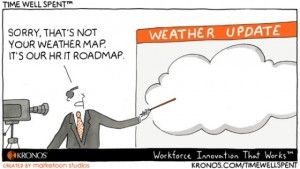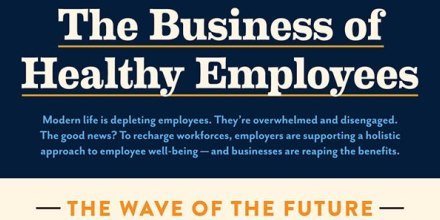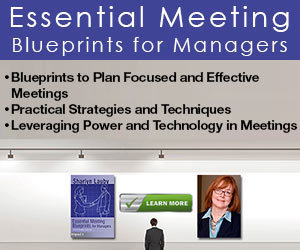Sharlyn J. Lauby's Blog, page 173
July 12, 2015
Innovation and the Origin of “Yes, And…”
I’ve always been fascinated by improv theater. During this year’s inaugural Work Human conference, Globoforce invited Boston’s Improv Asylum to conduct a session on business improv. I couldn’t resist the opportunity to learn more.
I know one of the key principles is the idea of “Yes, and…” What was great about the Improv Asylum’s session was how they used activities to help us understand where the phrase comes from and why it is important in business. Through a series of humorous sketches, they showed us how conversations evolve depending upon the way you respond. For example:
When we respond with “no”, the conversation is limited. The word “no” stops the idea from being developed. “No” can not only stall the idea but take the conversation in a negative direction. “No” can cause distrust and people will play it safe so they don’t run the risk of failure – whether that’s the person putting the idea on the table or the person saying “no”.
When we respond with being a “Devil’s advocate”, we can stop the conversation as well. Yes, it’s true that being a contrarian can bring value to the discussion. There are times when we need to consider the harshest critic. But only when it’s done at the right time and in the right way. If the majority of the discussion is focused on defending the idea, then Devil’s advocate is disrupting the process for not being supportive.
When we try to soften our skepticism with a questioning technique that can take the conversation in either a negative or positive direction. A rapid fire of questions can limit the conversation. You might think you’re clarifying details when you’re really shutting the conversation down.
Which leads us to where “Yes, and…” comes in. The goal is to move the conversation forward by adding to the initial thought. This isn’t as easy as it looks. To effectively use the “Yes, and…” technique, a person must be courageous enough to put their idea on the table AND confident enough to have their idea altered or expanded.
Organizational cultures that support the use of “Yes, and … “ are benefiting from the results created through the use of creativity and innovation . They are building cultures that are non-judgmental when it comes to ideas. All ideas are valuable because using the “Yes, and…” technique creates ideas that everyone helped to develop.
That’s what teamwork is all about. It’s not one person’s idea. It’s everyone’s idea. And the way it becomes everyone’s idea is through the use of “Yes, and…”
If you want to introduce the idea of “Yes, and…” to your organization, here’s a quick meeting icebreaker you can use to start the dialogue. It’s based upon the 1971 television series “Electric Company”. Break the group into pairs. Have one person say the first word that comes to mind. The second person needs to put another word with it. The pair then says the new word. Example:
1st person “Car”
2nd person “Sun”
Together “Carson”
The point of the activity is that two people were able to work together to create something new. “Yes, and…” allows the company to make that happen on a bigger scale. Think about what your organization could accomplish if the answer to every question was “Yes, and…”
Image courtesy of Sharlyn Lauby
The post Innovation and the Origin of “Yes, And…” appeared first on hr bartender.






July 10, 2015
Make Sure Your Employees Know the Plan – Friday Distraction
We’re officially in hurricane season here in South Florida. That means we need to dedicate some time to reviewing our annual disaster recovery plan. Regardless of the size of your business, it’s important to be prepared. And your employees need to be prepared as well.
From the hurricane perspective, I can’t emphasize enough developing an inclement weather plan. Know what you’re going to do with furniture, fixtures and equipment. How will computer back-ups get handled? Make sure employees have a way to communicate with the company. You don’t know when you will be faced with a storm.
But today’s Time Well Spent from our friends at Kronos made me realize that, when we talk about making sure your employees know the plan, we’re not just talking about disaster planning.
Organizations need to share with employees their technology plan. If we want employees to embrace technology and use it to its fullest potential, they need to understand the roadmap. It’s like the research that shows employees perform better when they understand how they impact the bottom-line. Employees will use technology more effectively when they understand how the technology impacts the business.
The plan will be successful when everyone knows it. And supports it.
The post Make Sure Your Employees Know the Plan – Friday Distraction appeared first on hr bartender.






July 8, 2015
4 Ways to Use Your Onboarding Technology For More Than Onboarding
(Editor’s Note: Today’s post is brought to you by our friends at SilkRoad , a leading global provider of cloud-based talent management solutions. SilkRoad recently launched an online resource center showcasing how Human Resource Management Systems can benefit your bottom line. You can check it out here . Enjoy the post!)
I must admit, I was a bit surprised by this conversation. At this year’s SilkRoad Connections conference, attendees were talking about new ways to use their onboarding solution for more than onboarding.
Let’s start at the beginning. We all know what onboarding is. The Society for Human Resource Management (SHRM) defines it as “the process by which new hires get adjusted to the social and performance aspects of their jobs quickly and smoothly, and learn the attitudes, knowledge, skills, and behaviors required to function effectively within an organization.”
And we all know why onboarding is important. A recent Fast Company article stated that 31 percent of new employees quit a job within the first six months. Turnover is expensive so onboarding needs to be effective and efficient. So onboarding is critical for employee engagement and retention. Why does it need to do more?! Can’t it just be used for onboarding? And then I realized, I was thinking about onboarding like a unitasker.
If you’re not familiar with the term, unitaskers are items that can only do one thing. Mr. Bartender and I are fans of the show “Good Eats” and Alton Brown is famous for bashing unitaskers in the kitchen. An example would be a corn kernel remover. Unitaskers don’t offer versatility and therefore, don’t bring much value.
The message for HR is, onboarding is not and should not be considered a unitasker. During the conference, we talked about four key processes where onboarding can bring value.
Internships: Many companies are investing heavily in their internship programs. They know today’s intern could be tomorrow’s employee. Just because an intern is only going to be with the company for a short while doesn’t mean they don’t need badges, computer access and a basic amount of training (at minimum ethics, customer service, anti-harassment, etc.)
An onboarding solution can be configured to support the company’s internship program. Special messaging can be created for interns to welcome them, explain the program and share expectations.
Work events: These are employee transition events such as mergers, acquisitions, and promotions. It could include employee transfers (both within the same country as well as expatriate assignments). Work events can also involve leave of absences. Employee work events trigger the need for new name badges, business cards, enhanced perks and benefits. It might also prompt additional training such as supervisory skills or safety training for a new piece of equipment.
An onboarding solution allows the company to not miss the details. There’s nothing worse than the disappointment of getting a promotion and someone forgetting to order new business cards. Or the employee that transfers to a new department but their name badge still has the old department on it.
Contingent workforce: Organizations are relying upon freelancers, consultants, and contractors to get work assignments completed. To keep these contingent workers engaged, they need to feel that they are a part of the culture. That means giving them badges so they don’t have to sign in as a visitor all the time. Possibly even giving them computer system access.
Onboarding solutions can be used to monitor contingent worker relationships. Everything from forms (i.e., mutual nondisclosure agreements and W-9s) to ID, keys and equipment. The key to successful contingent workforce management is making those workers feel like part of the team.
Offboarding: Regardless of the circumstances, making sure exiting employees bring closure to their employment experience is important. Word-of-mouth and “word-of-mouse” travels too fast. Companies do not want former employees holding grudges. Creating a thorough and efficient offboarding process is a win-win for everyone.
Onboarding solutions can be used to collect employee items such as badges, keys and equipment. It can also be used to disable access to company networks. Exit interviews can be initiated from onboarding technology. As well as outplacement services.
Onboarding: more than just a means to process new hires
Click To Tweet
So, as you can see, onboarding technology offers more than a means to process new hires. It can help companies manage talent, keep track of the details when employees have special work events, and provide a method for smooth transition out of the organization.
If you want to learn more about using your onboarding system for offboarding, download SilkRoad’s whitepaper on “The Rhyme and Reason for Offboarding”. It contains everything you need to know when building an offboarding experience. You can also subscribe to the SilkRoad blog to learn more about using human resources technology to benefit the bottom line.
The post 4 Ways to Use Your Onboarding Technology For More Than Onboarding appeared first on hr bartender.






July 6, 2015
Company Refuses to Reimburse Expenses – Ask #HR Bartender
I’ve always said never mess with an employee paycheck. Especially final paychecks. But do the same rules apply to expense reports? That’s what today’s reader question is all about – expense reimbursements.
I left my employer to take a position in my field. Now they are refusing to reimburse expenses which I incurred during the final month of my employment. My monthly allowance for expenses is $250. Please let me know if there is anything I can do or if they are obligated to pay me. Thank you.
Because we don’t know what the company policy is about expense reimbursement (or if they even have a policy), it’s impossible to directly answer the question. But the reader does bring up a good point about expense reimbursements and can they be viewed the same as pay.
To help us understand the nuances in this situation, I’ve asked Kate Bischoff, JD, SPHR, an employment attorney with the firm of Zelle Hofmann. She’s always offering up great insights on SHRM’s NextChat (Twitter chat) and she graciously agreed to help answer this question. Please remember that her comments should not be construed as legal advice or as pertaining to any specific factual situations. If you have detailed questions, they should be addressed directly with your friendly neighborhood labor attorney.
Kate, are reimbursable business expenses considered part of an employee’s wages?
[Kate] No. Under the Fair Labor Standards Act, specific types of payments are considered part of a wage calculation, but reimbursable business expenses are not part of that equation.
We don’t know if there was a company policy in place regarding expense reimbursement. That raises the question “Should companies have expense reimbursement policies?” Why or why not?
[Kate] Money is a highly sensitive subject for employers and employees alike. Expense reimbursement involves employee money, so clear communication on the procedures and what qualifies for reimbursement can provide some necessary transparency when issues like this come up. Without a clear policy, disputes are bound to happen.
The reader question mentions “allowance” which could be interpreted differently than “reimbursement.” Are the words interchangeable or different in terms of entitlements and payouts?
 [Kate] They are different. Usually, ‘allowance’ means that an employee may incur expenses up to a certain threshold each month, year, etc., and any amount over that threshold would be the responsibility of the employee alone. For example, if Sally had an expense allowance of $100 per month for mobile service and she chose a $120 plan, she would have to pay the extra $20 per month and would not be eligible for additional reimbursement. Under an allowance plan, Sally would not have to submit receipts for her mobile service. Allowances give employers a certain amount of consistency for their business expenses while giving the employee options on how they’d like to spend the money.
[Kate] They are different. Usually, ‘allowance’ means that an employee may incur expenses up to a certain threshold each month, year, etc., and any amount over that threshold would be the responsibility of the employee alone. For example, if Sally had an expense allowance of $100 per month for mobile service and she chose a $120 plan, she would have to pay the extra $20 per month and would not be eligible for additional reimbursement. Under an allowance plan, Sally would not have to submit receipts for her mobile service. Allowances give employers a certain amount of consistency for their business expenses while giving the employee options on how they’d like to spend the money.
‘Reimbursement’ generally requires that an employee submit receipts for business expenses, like travel, mobile service, meal and client entertainment expenses. Keeping track of the receipts and filling out expense reporting can be a hassle for employees, but can give employers a certain amount of control over how money is spent. Also, reimbursements can change dramatically month-to-month and year-to-year, so that approach can be unpredictable for companies looking to keep costs low.
The reader also mentions “expenses incurred.” Crazy question – If I purchased something for my company and they never reimbursed me, would I be entitled to keep it?
[Kate] That’s not a crazy question! It is certainly possible, but in the most lawyerly response I’ve got – I’d need more information. The law would need to know what the purchase was, whether it was authorized, and under what circumstances it was made. A court would likely find that you were either entitled to reimbursement for the expense or entitled to keep what you bought.
(Editor’s note: I love the term lawyerly.)
One last question, if a person feels their final paycheck isn’t correct, what can they do?
[Kate] Employees have a couple of options if they think their final paycheck is incorrect. They can and probably should ask for an explanation, in writing, from the employer. If the employer won’t explain or the explanation is unsatisfactory, the employee can contact their state department of labor (or similar agency) that enforces wage payment laws. While state agencies can take some time to process wage claims, this is a no-cost option for employees.
The other option is to bring suit against the employer in court. For many employees, this could be done in conciliation court (if the amount owed is under the dollar threshold that varies by state, county or municipality). Employees do not need an attorney to file a claim, and it’s possible the claim could be resolved quickly. If the employee wants to hire an attorney, the attorney may bring an action in district court and attempt to recover the employee’s attorneys’ fees and costs as well, which most wage laws permit. This option can be costly for the employee initially (i.e., paying the court filing fees) and can take significant time.
Many thanks to Kate for sharing her experience with us. Be sure to follow her on Twitter and check out the Zelle Hofmann blog, The Employment Law Navigator.
Whether it’s an employee’s paycheck or their expense report, the conversation is about money and no one enjoys having their money taken away from them. Organizations need to clearly communicate expense reimbursement and allowances so employees do not have their purchases denied. No one wins in these situations.
Image courtesy of Sharlyn Lauby
The post Company Refuses to Reimburse Expenses – Ask #HR Bartender appeared first on hr bartender.






July 3, 2015
Healthy Employees = Healthy Business [infographic] – Friday Distraction
Businesses today are under tremendous pressure to produce results. As a consequence, employees are under pressure to produce.
Now, don’t get me wrong. Companies do need to accomplish their goals and deliver results. Same with employees. They need to be accountable and productive. But both organizations and employees need to be smart about it.
That’s the message in this infographic from Virgin Pulse, titled “The Business of Healthy Employees.” Creating a culture that values well-being makes sense for the company and its employees. Healthy employees bring their A-game to work every day.
One of the other things I like about Virgin Pulse’s approach is their definition of well-bring. It goes beyond the traditional concept of wellness, which focuses on the physical fitness component. In addition to wellness, well-being includes liking the work you do at work and at home, having supportive relationships, managing finances well, and being a part of a community.
Healthy employees = healthy business
Click To Tweet
Well-being is a growing issue on everyone’s mind. Employees want to know their company supports it. And businesses want to know their employees have it. We might be approaching a time when everyone turns to HR and asks, “What are you doing about it?”
The post Healthy Employees = Healthy Business [infographic] – Friday Distraction appeared first on hr bartender.






July 1, 2015
Creating Strategy and Being Strategic Aren’t the Same Thing
(Editor’s Note: Today’s post is an excerpt from my book, “ Essential Meeting Blueprints for Managers .” The book is available on Amazon in hard copy and Kindle , in the iTunes store, and directly from the publisher.”
Before we can talk about strategic planning, it’s important to discuss the difference between creating a strategy and being strategic. Just because someone can create a strategy doesn’t mean they can think strategically.
According to the Cambridge dictionary, strategy is a detailed plan for achieving results. There are many different kinds of business strategies – marketing strategies, compensation strategies, recruitment strategies, social media strategies, even strategic plans. You get the point.
Thinking strategically means a person is capable of a thought process that allows them to facilitate a dialogue of critical thinking and innovation. This isn’t to say that the two aren’t interrelated. Creating strategy is important for business. But strategic thinking is a competency that needs to be developed.
If you are interested in exploring the connection between these two concepts, Jeanne Liedtka penned a fascinating article on the five elements of strategic thinking titled “Linking Strategic Thinking with Strategic Planning” that really deserves a read. As business professionals, I wonder how much time and emphasis we are placing on these elements:
Systems perspective (i.e. having the ability to see the entire picture).
Intent-focused, which is being able to create a focus for employees to concentrate on the goal.
Intelligent opportunism reminds us of the conversations happening about the opportunity economy and being open to new ideas that are good for business.
Thinking in time refers to the view of referencing the past to create the future. And using the proper analogies to create linkages and anticipate trends.
Lastly, being hypothesis-driven. Yes, the classic scientific theory rears its head. Being able to reason and test a hypothesis is key to effective strategic thinking.
For business professionals, this means relying less on gut instinct and more on analytics. We need to shift our focus from a “been there, done that, so I know the answer” to a “been there, know what happened, now let’s apply the learnings to our current situation.”
It’s easy to see the value in strategic thinking. Being able to effectively apply our theoretical knowledge and in-the-trenches experience will serve us well.
The post Creating Strategy and Being Strategic Aren’t the Same Thing appeared first on hr bartender.






June 28, 2015
Everything #HR Needs To Know About SEO
I believe that one of the most mysterious technology terms out there is SEO (aka Search Engine Optimization). Lots of people claim to be SEO experts. Many folks will tell you to do this or that because it “improves SEO.” But honestly, what does that mean?
A couple of years ago, I had the opportunity to hear Susan Vitale, chief marketing officer at iCIMS, talk about SEO in the context of human resources. It was a super interesting webinar so I asked Susan if she would share her expertise with us. Thankfully, she said yes.
Susan, briefly describe for readers what Search Engine Optimization (SEO) is and why we should care about it.
 [Susan] SEO is the practice of improving the visibility and ranking of a website in a search engine’s ‘organic,’ or unpaid, results. In most cases, the higher a website ranks on the search results page, the more visitors to the website it will receive from the search engine’s users.
[Susan] SEO is the practice of improving the visibility and ranking of a website in a search engine’s ‘organic,’ or unpaid, results. In most cases, the higher a website ranks on the search results page, the more visitors to the website it will receive from the search engine’s users.
HR professionals should care about SEO because it is crucial to their talent acquisition efforts. Although traditional recruitment advertising techniques generate visits to your career site, more and more candidates are using major search engines like Google or Bing to find jobs.
One of the first things job seekers do in their quest to find their dream job is to simply run a Google search of their desired job title, plus a location. Here’s what happens each month:
There are 7 billion searches performed online, 11.9 billion on Google alone.
Over 300 million job-related searches take place on other search engines. (Source: DirectEmployers)
The challenge is this: If you were to search for a job opening, there will typically be far too many results to go through (for example, a Google search for marketing jobs in New Jersey yields about 40,100,000 results). Most of the results on the first page are populated by job board sites and websites such as Craigslist. With Google only displaying 10 results per page, competition for these spots can be very intense. Companies need to find ways to raise their profile on search engines. Fortunately all of this can be addressed to work in your favor if you put the right practices into place to make your careers site more SEO-friendly.
I’ve always found SEO to be very broad in scope. At times, it can appear a bit overwhelming. What areas do you see as having the greatest potential to be overlooked? And, if HR only has time to focus on one aspect of SEO, what should that be?
[Susan] Mobile optimized career microsites are becoming an important part of companies’ SEO strategies for talent acquisition because they help drive traffic to their career portals. Career microsites are small search engine optimized websites that advertise your jobs and point traffic to your career portal. Unlike traditional job boards, a career microsite is like your company’s own job board, in that it is fully branded and can include additional information to sell your company.
The real power of the career microsite and the main difference between a career microsite and a career portal is the website address, or the URL. A strong URL is a key component in SEO which drives traffic to your site by helping your company rank higher in a standard, non-branded (meaning, not using your company name) Google search. It is an independent website using keywords and the .JOBS domain to support an improved search engine ranking. A company’s career portal, however, uses a .com domain and a branded website address. Because of this, the career portal does not rank as high on non-branded searches with any of the most popular search engines like Google, Bing or Yahoo.
The value of the career microsite, therefore, is that in using SEO techniques, your career microsite and your job postings rank more highly in a Google search. This allows your open positions to be found, even if a candidate does not know your company name and performs a Google search using generic job titles or locations.
SEO changes so much, as evidenced by the recent Google algorithm change giving preference to mobile optimized sites. Are there 2-3 SEO basics that everyone can and should remember?
[Susan] Google changed its algorithm to rank mobile friendly sites higher in search rankings. This is BIG news for businesses that rely on organic website traffic. It’s also important for employers who use their career microsite to attract and hire top talent since Google’s new algorithm will bump down sites in search rankings that are not mobile optimized.
Talent recruiters are potentially losing out on due to obsolete technology. Consider these statistics:
Based on iCIMS’ in-platform data consisting of more than 2,700 employers in varying industries, we see that mobile usage among job seekers has increased by 60 percent in the past year alone.
According to a recent study by Aberdeen Group, 70 percent of respondents said they have used their mobile devices to search for jobs, and 51 percent are already applying for jobs on mobile.
In a Careerbuilder candidate behavior study, 65 percent of workers who search for jobs via mobile devices will leave a website if it isn’t mobile-optimized, and 40 percent walk away with a more negative opinion of the company.
The disruptive force of technology has permanently changed the way people apply for jobs and how companies hire, leaving dramatic and lasting effects on talent acquisition practices. From the rise of job aggregator apps to social recruiting to increased video usage among both job seekers and employers, a digital revolution has surely taken place in the industry today. A recent survey from Glassdoor even showed that 9 in 10 jobseekers expect to use their mobile device during the job search process in the next 12 months.
The most basic takeaway for recruiters: if your career site is not mobile-optimized you’re already missing out on a massive number of potential candidates.
If a company is doing SEO right, what kind of results should they expect? Conversely, how can someone tell if they’re doing SEO wrong?
SEO should be part of an overall employment branding strategy that is driven by the career microsite capable of being viewed on any device. Having a consistent, well-branded company presence online and on social networks will make SEO simpler and more effective. In the end, the number and quality of candidates should increase over time due to higher search rankings and resulting traffic.
Therefore, measurement is also key. SEO is not a ‘one and done’ activity; it is an ongoing effort, so the ability to measure the success of an SEO strategy is necessary to constantly improve it. To ensure positive results, measure and track the candidate sources that are performing best for each type of role, which will enable the company to meet specific objectives and achieve maximum return on investment.
Here’s everything #HR needs to know about SEO
Click To Tweet
My thanks to Susan for sharing her expertise. iCIMS has been a long-time supporter of HR Bartender. If you’re looking for more resources, tips and best practices, be sure to check out the iCIMS Hire Expectations Institute. They have an SEO for Career Sites whitepaper
While a recent study from Appcast.io shows 50 percent of job seekers use their mobile phones to search and apply for jobs, don’t panic if you’re career site isn’t mobile optimized. The good news is there are talent acquisition suite providers, like iCIMS, who can make it easy for companies. They employ a responsive design technique to automatically accommodate the appropriate viewing experience whether the candidate is on a desktop, smartphone or tablet.
It’s not about doing everything yourself. It’s about understanding enough to know when to partner.
Image courtesy of Sharlyn Lauby
The post Everything #HR Needs To Know About SEO appeared first on hr bartender.






June 26, 2015
Quick Shots for #HR and Business Pros – #SMDAY
Tuesday, June 30 is Social Media Day. It was started in 2010 by Mashable to recognize and celebrate social media’s impact on global communication. Many cities host a local version – here’s what my community in South Florida is doing. If your city isn’t doing anything, then at least participate by expanding your social network by one meaningful connection. That was Mashable’s goal in 2014, but really I don’t see why that shouldn’t be a goal every year.
As human resources pros, social media has become part of the way we do business. Often the first thing that comes to mind is social recruiting. I partnered with iCIMS a while back on a whitepaper titled, “4 Steps to Social Recruitment”. You can download a copy here.
But there’s more to social than recruiting. In fact, if your organization already has a social recruiting strategy in place, that sets the stage for social learning. Tony Bingham, president and CEO of the Association for Talent Development (ATD), has released the 2nd edition to his very insightful book “The New Social Learning”.
That’s not all. If you’re using social to hire the best talent and social to help them grow, then why wouldn’t you use social to recognize their efforts. Check out this Ventana Research report sponsored by Globoforce on “5 Reasons to use Social Recognition in Business.”
I really think one of the biggest takeaways we need to realize from social media is about learning what works best for each individual both personally and professionally. We don’t have to do it all but we need to give things a try. Check out my 5-Day Learning Plans as a way to test drive some of the more popular social media platforms. You can also share these with friends, family and colleagues who are trying to figure out a new platform as well.
Facebook | Instagram | LinkedIn | Pinterest | Twitter | YouTube
It’s hard to believe that social media day has been around for six years! A clear sign that we need to embrace it and make it a part of our lives. That doesn’t mean it needs to control us. It means we need to learn more so we can use it effectively.
Image courtesy of Sharlyn Lauby
The post Quick Shots for #HR and Business Pros – #SMDAY appeared first on hr bartender.






June 25, 2015
Hello #SHRM15 Conference Attendees!
Tomorrow I’m heading to Las Vegas. I’m attending the Society for Human Resource Management (SHRM) Annual Conference. This isn’t my first SHRM Annual – in fact, my first SHRM conference (more than a few years ago) was also in Las Vegas. At that time, a small earthquake happened – let’s hope history doesn’t repeat itself.
The reason I’m writing this post is because last year I attended a blogging conference and, during the event, I met someone who posted an introduction on her blog. It made me realize that sometimes we take for granted that everyone knows who we are and what we’re all about.
For those of you who are regular readers of HR Bartender, thank you so much! I very much appreciate it. And for those who don’t know much about HR Bartender, here’s a quick intro:
I’ve been blogging for about 7 years. You might be wondering where the name HR Bartender comes from. Here’s an explanation. A recently SHRM survey named HR Bartender one of the top five blogs read by human resources professionals.
When I’m not blogging, I’m a training and human resources consultant. I have clients all over the world but most of my work in done in South Florida. Oh, and I just published my first book, “Essential Meeting Blueprints for Managers.”
I believe strongly in volunteerism. I’ve served as president of my local SHRM chapter as well as director of the Florida State Council, also an affiliate of SHRM. I served by appointment from then Florida Governor Jeb Bush to the Governor’s Alliance for the Employment of Citizens with Disabilities. Currently, I serve as co-lead on the SHRM Ethics and Corporate Social Responsibility special expertise panel.
Welcome to #SHRM15 – I’ll see you there!
Click To Tweet
If you happen to be at the conference, I will be speaking on the SmartStage on Wednesday, July 1 at 11:30a on “Office Politics and Meetings: How to Manage Egos and Expectations.” I hope you’ll find time to stop by and say hello.
So that’s a bit about me…your turn! Tell us about yourself.
The post Hello #SHRM15 Conference Attendees! appeared first on hr bartender.






June 23, 2015
Pre-Boarding: Bring High Tech and High Touch to Onboarding
(Editor’s Note: Today’s post is sponsored by Xerox . For more than a half a century, Xerox has been a leader in document technology and services. Xerox Content Management Services helps organizations organize, classify and manage their most critical data. Enjoy the post!)
In his 1982 book “Megatrends”, John Naisbitt coined the phrase ‘high tech, high touch.” The idea being that the more technology we are exposed to, the more of a personal touch we want in our interactions. There’s never been a better case study for this than onboarding.
The Society for Human Resource Management (SHRM) defines onboarding as “the process by which new hires get adjusted to the social and performance aspects of their jobs quickly and smoothly, and learn the attitudes, knowledge, skills, and behaviors required to function effectively within an organization.” Organizational culture defines when the onboarding process starts and ends.
Regardless of when our company’s onboarding begins and concludes, one thing is consistent – there are three primary stakeholders in the process:
The new hire employee is excited about their new role with the company. They want to make a great first impression. They want to do awesome work. And they also want to know about things like when they’re going to get paid and how to sign up for benefits.
The hiring manager has invested a lot of time finding the new employee. Maybe they’ve been running the department short staffed and can’t wait for the new hire to start. Maybe this is a new position and the employee will be helping the department achieve their stretch goals. The hiring manager wants to get their new employee trained and working ASAP.
Human resources is responsible for making sure that the new employee is welcomed into the organization and effectively brought onto the payroll. They need to make sure all the “i’s are dotted and t’s are crossed”
However, if #3 (the human resources part) doesn’t happen, then the employee and manager aren’t positioned for success. The employee is distracted because they don’t have answers to their questions about pay, benefits, etc. The manager isn’t able to spend time building a relationship with the employee because they are trying to get the administrative part of the process finalized. So how do we make sure that the onboarding process achieves the benefits of being both high tech and high touch?
I’ve been hearing the term “pre-boarding” a lot lately. Pre-boarding is defined as laying the groundwork for an employee’s first day on the job. Pre-boarding is the step in the onboarding process that creates success for the employee and the manager. Once the groundwork is finished, the manager and employee can dedicate their focus to the job and building a good working relationship.
Pre-boarding automation is the key to effective onboarding
Click To Tweet
Which is why I wanted to share with you a few highlights from my test drive of Xerox’s new Workflow Automation Solution for HR Onboarding. While the solution provides support for the entire onboarding process, it really shines when it comes to setting human resources, employees and managers up for success during the crucial pre-boarding process.
Powerhouse – – The Xerox Workflow Automation Solution for HR Onboarding is able to handle batch processing of documents. In my past corporate roles, we would often hire several interns or seasonal employees at the same time. This solution gives me the ability to send multiple offers at the same time. The faster I can bring employees into the organization, the happier everyone will be.
Configurable – – Create custom forms using the solution’s Form Builder. Every organization has at least one unique form. It might be for an employee benefit or maybe emergency contacts. This solution gives you the ability to create your own forms and distribute them accordingly.
Agility – – It’s compatible with your existing software. One of the things I liked about the Xerox solution was its ability to work with Microsoft Outlook. Let’s face it, we still get resumes and inquiries via email. With the HR onboarding solution, I’m able to immediately move those documents. No separate sign in, just a click of a mouse.
If you want to learn more, check out the Xerox Workflow Automation Solution for HR Onboarding website and download this case study with Convergys Corporation. We know the challenges with onboarding administration. It does a great job of sharing the results we can expect: a highly configurable onboarding process.
That’s what stakeholders are looking for. They want the efficiency and scalability that technology offers with the responsiveness and individuality that create an engaged and productive workforce. It’s up to human resources to make that happen.
The post Pre-Boarding: Bring High Tech and High Touch to Onboarding appeared first on hr bartender.






Sharlyn J. Lauby's Blog
- Sharlyn J. Lauby's profile
- 10 followers


















